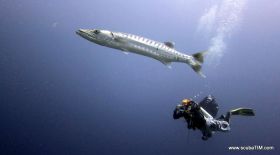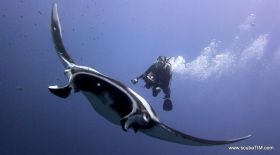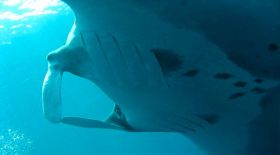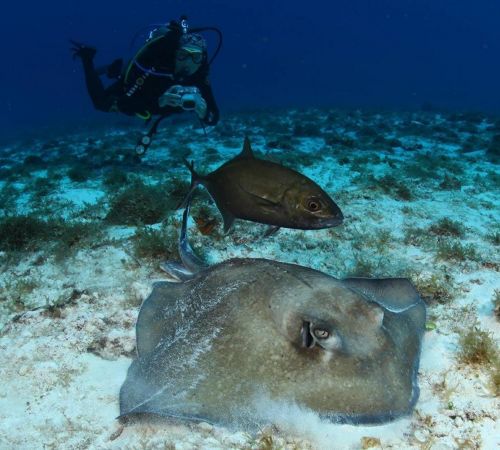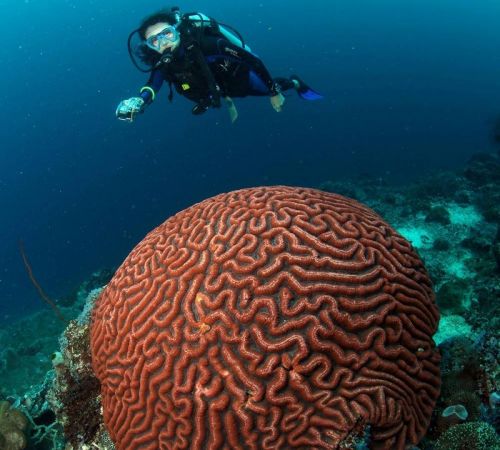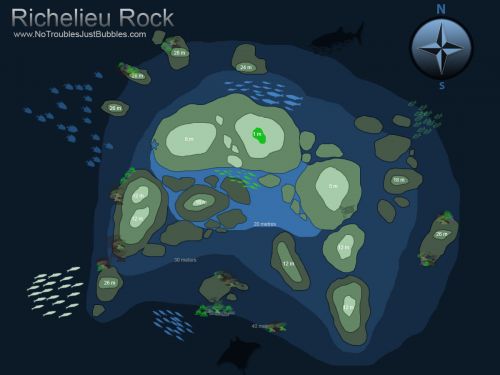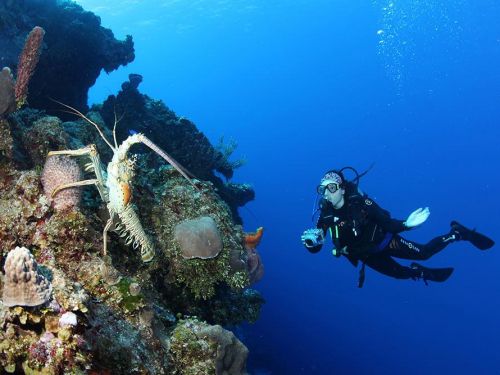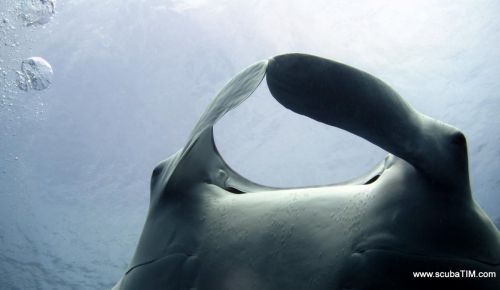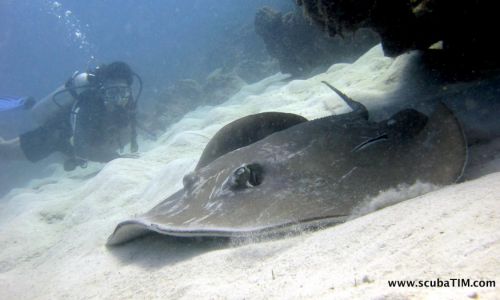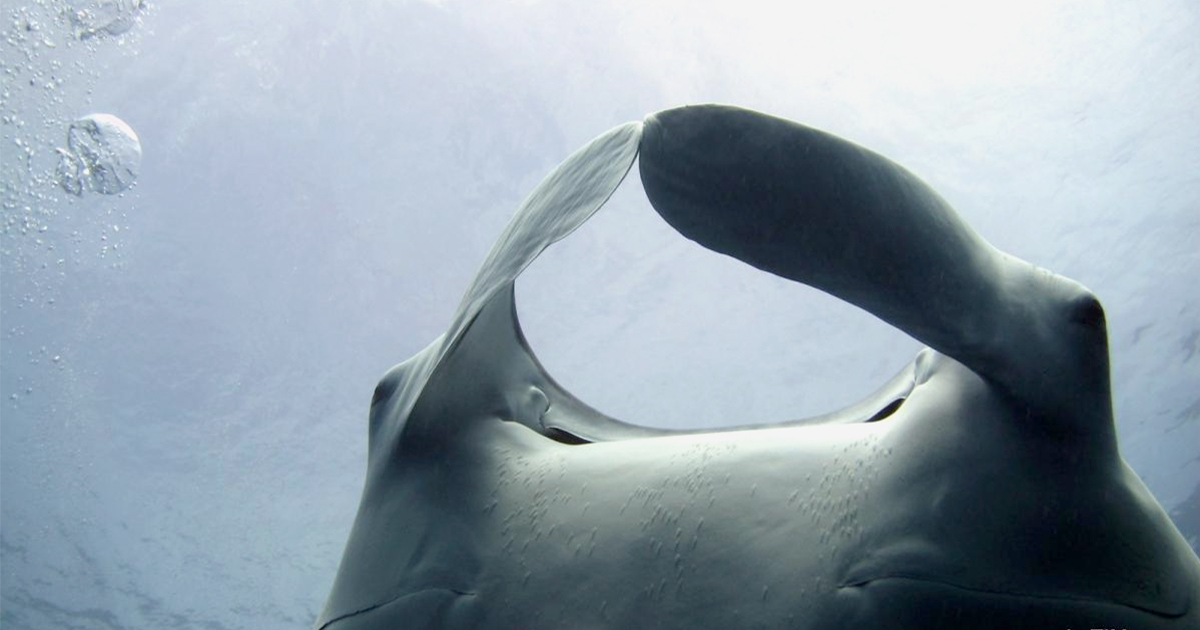 Richelieu Rock Photo by ScubaTim
Richelieu Rock Photo by ScubaTim
Without doubt, the best dive site in Thailand is Richelieu Rock. It’s not suitable for beginners, and it’s located in open sea quite far out from the coast or any islands, but it’s well worth the effort to visit. It is a world-class dive site, and for good reason. The abundance of life around this undersea pinnacle is truly amazing. In fact, many Richelieu Rock liveaboard cruises stay there for the whole day, diving three or even four times. And it doesn’t matter if there is a strong current or lots of other divers on the day that you visit, because the dive site is large enough and has plenty of shelter. If you are a certified diver with ten or more logged dives, a liveaboard cruise or a day trip to Richelieu Rock should be on your list of what to do when diving in Thailand.
Where is Richelieu Rock?
Richelieu Rock is officially part of the Surin Islands National Marine Park, but it is most commonly visited on a Similan Islands liveaboard diving cruise. It’s on the west coast of southern Thailand, not far from the border with Myanmar. Richelieu Rock is in deep & open water, with the Surin Islands the nearest land.
In a straight line from Koh Ra on the mainland to The Surin Islands, Richelieu Rock is two thirds of the way, nearer to The Surin Islands than to Koh Ra. Baan Nam Khem is on the mainland of Thailand, in the northern part of Phang Nga Province. This is the departure pier for Richelieu Rock day trips, but most Richelieu Rock scuba diving trips are by liveaboard. They usually use Tab Lamu Pier, and visit The Similans, Koh Bon & Koh Tachai first.
What Makes Richelieu Rock so special?
Being located in deep water far from land means that Richelieu Rock isn’t affected by pollution or too many tourists. Also, the surrounding water is deep in all directions, and this makes it like an oasis in the desert, attracting lots of life. There are millions of creatures at Richelieu Rock, some live there and others visit to feed, breed or be cleaned. Nutrient-rich currents from several directions ensure that Richelieu Rock is permanently supplied with vital plankton. The size of the Richelieu Rock dive site and the fact that there are so many things to see there makes it a very special place. It’s easily possible to dive three or more times on the same day and still enjoy every dive like it’s a new one.
How Best to Enjoy Richelieu Rock Thailand
There are two ways to visit Richelieu Rock
- On a Richelieu Rock liveaboard boat
- On a Richelieu Rock day trip boat
There are only two ways to visit Richelieu Rock for scuba diving in Thailand. These are by day trip from Khao Lak or by liveaboard diving cruise from Khao Lak, Phuket or Ranong. It’s not possible to join on a day trip from Phuket, and boats don't normally offer Richelieu Rock snorkelling options.
Richelieu Rock Liveaboard
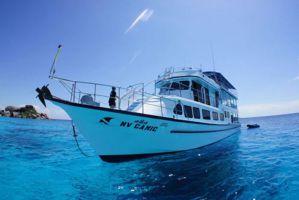 A Richelieu Rock liveaboard diving cruise is by far the best way to enjoy it. Nearly all liveaboard trips to Richelieu Rock will have already visited Koh Tachai & Koh Bon on the way, and many will have also started at The Similan Islands before that. Saving the best to last, the liveaboard boats arrive during the night and you get to dive Richelieu Rock early in the morning before any day trip boats arrive. There’s also something special about getting in the water soon after sunrise, when all the fish are also just starting their day. Not only do you get more dives at Richelieu Rock than on a day trip, the dives are better and so are surface intervals because you’re on a large boat, not a speedboat.
A Richelieu Rock liveaboard diving cruise is by far the best way to enjoy it. Nearly all liveaboard trips to Richelieu Rock will have already visited Koh Tachai & Koh Bon on the way, and many will have also started at The Similan Islands before that. Saving the best to last, the liveaboard boats arrive during the night and you get to dive Richelieu Rock early in the morning before any day trip boats arrive. There’s also something special about getting in the water soon after sunrise, when all the fish are also just starting their day. Not only do you get more dives at Richelieu Rock than on a day trip, the dives are better and so are surface intervals because you’re on a large boat, not a speedboat.
Richelieu Rock Day Trip
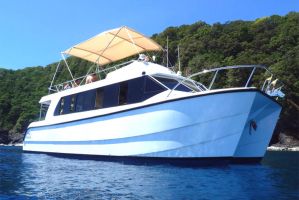 Day trips to Richelieu Rock are extremely popular, and most boats’ trips are sold out during the high season. Leaving from a pier north of Khao Lak, the day trips use speedboats to get there in just over one hour. This gives you enough time for two full dives, and you get back to Khao Lak around 4pm.
Day trips to Richelieu Rock are extremely popular, and most boats’ trips are sold out during the high season. Leaving from a pier north of Khao Lak, the day trips use speedboats to get there in just over one hour. This gives you enough time for two full dives, and you get back to Khao Lak around 4pm.
A day trip to Richelieu Rock from Phuket is not practical, and something that we don’t offer. Phuket airport is at least one hour south of central Khao Lak. The main beach areas of Phuket are even further away. And Richelieu Rock day trips don’t sail from central Khao Lak, they sail from Baan Nam Khem, which is 30 or more minutes further north. Therefore, to arrive in time for a morning departure would involve 2-3 hours on the road before starting the boat trip. In addition, our Richelieu Rock day trip operators normally require divers to ‘check in’ at the Khao Lak dive centre the day before a trip.
Richelieu Rock Snorkeling
Because Richelieu Rock is a pinnacle in exposed deep sea far from land, it gets waves and has no shelter from nearby land or an island. Snorkel trips to Richelieu Rock are not common, but they are possible. Most of our day trips & liveaboards to Richelieu Rock do not offer snorkelling opportunities. If the sea conditions are suitable and snorkellers are able to take a breath & dive down a few metres, it’s a wonderful experience. The Rock is visible above the surface during low tide, and there is lots of colourful & healthy marine life all the way to the top. But being able to snorkel at Richelieu Rock is dependent on the conditions on the day, and the captain's decision.
Who Can Dive at Richelieu Rock?
| Diver Cert. Level | Can Dive? | Limitations | Notes |
| Absolute beginner | NO | Depth | This option is not available |
| Open Water Student - Dives 1 & 2 | NO | No sandy bottom | A sandy bottom is required to practise skills |
| Open Water Student - Dives 3 & 4 | YES | 18 metres | Good sea conditions are necessary |
| Open Water Diver | YES | 18 metres | Excellent diving, but some fish species are too deep to see |
| Advanced Open Water Diver | YES | 30 metres | See the Seahorse & Ghost Pipefish first, then ascend slowly |
| Rescue Diver / Divemaster | YES | 30 Metres / None | Lots & lots to see at all depths |
| Professional Diver | YES | None | Many special species, large & small can be seen |
For several reasons, it’s not possible for complete beginners to dive at Richelieu Rock. Complete beginners & those on the first day in the sea of their Open Water Course need a sandy seabed to kneel down and practise a few simple skills. Also, such inexperienced divers often feel more comfortable when they can see land nearby or see the bottom of the sea.
Diving students doing Dives #3 & #4 can dive at Richelieu Rock because these divers don’t need to perform skills on a sandy bottom, and they can descend to 18 metres. Several liveaboards teach Open Water courses and include Richelieu Rock, but for most it’s on day 3 of the cruise, and the divers are already certified by then. The official rules prohibit learning to dive within the national marine park, and most operators will not teach the final dives of the Open Water Diver course at Richelieu Rock.
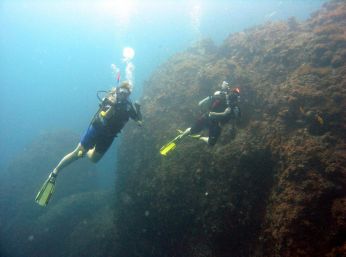 Open Water Divers will be in awe at Richelieu Rock. There is a vast amount of marine life from the surface all the way down to their 18-metre depth limit. Within this range they will be able to see thousands of fish, moray eels, Harlequin Shrimp and more. Yes, there are some special creatures deeper, but Open Water divers will still thoroughly enjoy every dive at Richelieu Rock Surin Thailand.
Open Water Divers will be in awe at Richelieu Rock. There is a vast amount of marine life from the surface all the way down to their 18-metre depth limit. Within this range they will be able to see thousands of fish, moray eels, Harlequin Shrimp and more. Yes, there are some special creatures deeper, but Open Water divers will still thoroughly enjoy every dive at Richelieu Rock Surin Thailand.
Advanced Open Water Divers (& OW Divers with the Deep cert.) are able to go down to 30 metres. This is where the resident Seahorse can be found, and the Ornate Ghost Pipefish is a little shallower. To be honest, although the bottom is a little deeper than 30 metres, and it gets deeper away from The Rock, there is very little to see. A maximum depth of 30 metres is perfect for a safe dive of up to an hour.
Rescue Divers, Divemasters and experienced divers of other levels will love Richelieu Rock. Whether you want to look for some special macro life, be in awe of the thousands of schooling fish, or look out for a Whale Shark or similar, Richelieu Rock diving Thailand has the best of the best. Wherever you look, there is something going on to grab your attention.
Professional divers love Richelieu Rock. This includes the local staff who go there several times per week and diving professionals from around the world. The dive site is large and absolutely full of life, including some species found nowhere else.
When to Dive Richelieu Rock
 Richelieu Rock Thailand diving is limited to the high season. This is from October 15th to May 15th every year. From mid-May until mid-October the area is closed to all public activity. The local authorities close the national marine parks during the Indian Ocean Monsoon season because of unpredictable and potentially rough seas. Fishing is also prohibited in the national marine parks throughout the year.
Richelieu Rock Thailand diving is limited to the high season. This is from October 15th to May 15th every year. From mid-May until mid-October the area is closed to all public activity. The local authorities close the national marine parks during the Indian Ocean Monsoon season because of unpredictable and potentially rough seas. Fishing is also prohibited in the national marine parks throughout the year.
For the first and final weeks of the diving season (late Oct & early May) some Richelieu Rock day trips need to be cancelled if the seas are too rough. But the Similan & Richelieu Rock liveaboard boats are usually not affected because they are large and they don’t rely on speed. December to early April is the best time to dive at Richelieu Rock because the sea & weather conditions are more likely to be better. There is no specific best time to dive with a Whale Shark or Manta Ray, but sightings are more common in March & April.
What to Expect at Richelieu Rock
Marine life
 The life at Richelieu Rock comes in all shapes and sizes. One thing is for sure, you will never feel that there is a shortage of fish. Thousands & thousands of schooling fish can be seen all around The Rock at all depths. These include Snapper, Trevally, Tuna, glassfish and many other species. Many species of Moray Eels can be found in nooks & crannies all over. These include common and rare species. Reptiles include a couple of species of turtles and sea snakes/kraits. Invertebrates are everywhere. For example, octopuses, squid, Mantis Shrimp and Harlequin Shrimp. A pair of very large Barracuda are often in quite shallow water, waiting for an opportunity of a quick meal. A couple of resident bony fish are almost guaranteed to be seen if you know where to look. These are the Yellow Tigertail Seahorse and the Ornate Ghost Pipefish. These individuals don’t swim very far, so Divemasters usually find them quite easily. Medium size sharks and rays can also be seen, including the occasional Guitar Shark, and much more common Blue Spotted Stingray. And last but not least, Richelieu Rock is a good place to see a Whale Shark or Manta Ray. These pelagic filter feeders are attracted to The Rock and they come from very far away to sieve plankton through their gills.
The life at Richelieu Rock comes in all shapes and sizes. One thing is for sure, you will never feel that there is a shortage of fish. Thousands & thousands of schooling fish can be seen all around The Rock at all depths. These include Snapper, Trevally, Tuna, glassfish and many other species. Many species of Moray Eels can be found in nooks & crannies all over. These include common and rare species. Reptiles include a couple of species of turtles and sea snakes/kraits. Invertebrates are everywhere. For example, octopuses, squid, Mantis Shrimp and Harlequin Shrimp. A pair of very large Barracuda are often in quite shallow water, waiting for an opportunity of a quick meal. A couple of resident bony fish are almost guaranteed to be seen if you know where to look. These are the Yellow Tigertail Seahorse and the Ornate Ghost Pipefish. These individuals don’t swim very far, so Divemasters usually find them quite easily. Medium size sharks and rays can also be seen, including the occasional Guitar Shark, and much more common Blue Spotted Stingray. And last but not least, Richelieu Rock is a good place to see a Whale Shark or Manta Ray. These pelagic filter feeders are attracted to The Rock and they come from very far away to sieve plankton through their gills.
Coral
 Richelieu Rock is covered in coral. This is mainly soft red coral, but there are other colours and hard corals, too. Also there are seafans of all shapes & sizes, and lots of anemones.
Richelieu Rock is covered in coral. This is mainly soft red coral, but there are other colours and hard corals, too. Also there are seafans of all shapes & sizes, and lots of anemones.
The dive site is surrounded by millions of fish, but even if all the fish went away, divers would still enjoy seeing the carpet of colours made by the corals all over Richelieu Rock. Luckily for us, the abundant & healthy corals attract life, and the fish and other species keep the corals healthy.
Size & Shape
 Richelieu Rock is large, and you can easily dive it several times on the same day without boredom or repetition. Its shape resembles a horseshoe, and this allows for diving in currents from any direction. Both around the outside of the horseshoe and in all areas inside there is not only lots of shelter from a current, but also more than enough to see. Unlike a lot of other world-class dive sites where a strong current can make a dive less enjoyable, Richelieu Rock can easily be dived in any conditions. There are a couple of well-placed permanent moorings for boats to drop off or meet divers. At high tide, the top of The Rock is hidden under the surface, but at low tide it can be seen.
Richelieu Rock is large, and you can easily dive it several times on the same day without boredom or repetition. Its shape resembles a horseshoe, and this allows for diving in currents from any direction. Both around the outside of the horseshoe and in all areas inside there is not only lots of shelter from a current, but also more than enough to see. Unlike a lot of other world-class dive sites where a strong current can make a dive less enjoyable, Richelieu Rock can easily be dived in any conditions. There are a couple of well-placed permanent moorings for boats to drop off or meet divers. At high tide, the top of The Rock is hidden under the surface, but at low tide it can be seen.
Something at all depths
 Another great thing about diving at Richelieu Rock is that there is something to see at all depths. Divers who are limited to shallower depths or those performing a safety stop can still enjoy lots of interesting marine life, even just a few metres from the surface. At even one metre from the surface down to more than 30 metres there is lots of life at Richelieu Rock.
Another great thing about diving at Richelieu Rock is that there is something to see at all depths. Divers who are limited to shallower depths or those performing a safety stop can still enjoy lots of interesting marine life, even just a few metres from the surface. At even one metre from the surface down to more than 30 metres there is lots of life at Richelieu Rock.
Pelagic visitors
 Whale Sharks, Manta Rays and other pelagic species are what many divers hope to see at Richelieu Rock, and this is possible but never guaranteed. The large species roam the seas & oceans and Richelieu Rock is an ideal place for them to feed or be cleaned. They come throughout the year, but more sightings tend to be reported in March & April. Whale Sharks and Manta Rays are not dangerous to humans, and both species will stay with a group of divers if they feel comfortable. Chasing them or trying to touch them is a big ‘no-no’ and this will only cause them to swim away, anyway. If you’re lucky enough to see either species, just stay still, stay calm and enjoy the moment.
Whale Sharks, Manta Rays and other pelagic species are what many divers hope to see at Richelieu Rock, and this is possible but never guaranteed. The large species roam the seas & oceans and Richelieu Rock is an ideal place for them to feed or be cleaned. They come throughout the year, but more sightings tend to be reported in March & April. Whale Sharks and Manta Rays are not dangerous to humans, and both species will stay with a group of divers if they feel comfortable. Chasing them or trying to touch them is a big ‘no-no’ and this will only cause them to swim away, anyway. If you’re lucky enough to see either species, just stay still, stay calm and enjoy the moment.
Clear water
 The sea around Richelieu Rock is very deep in all directions for a long way. The Rock is many miles from civilisation and therefore not affected by pollution. In general, the visibility is excellent. But sometimes a plankton bloom or thermocline will cause limited visibility. At other dive sites this may be a problem, but not at Richelieu Rock. When the visibility is reduced, you can simply look in and around the corals from close distance. You are very likely to see small species of fish or invertebrates that you would normally miss.
The sea around Richelieu Rock is very deep in all directions for a long way. The Rock is many miles from civilisation and therefore not affected by pollution. In general, the visibility is excellent. But sometimes a plankton bloom or thermocline will cause limited visibility. At other dive sites this may be a problem, but not at Richelieu Rock. When the visibility is reduced, you can simply look in and around the corals from close distance. You are very likely to see small species of fish or invertebrates that you would normally miss.
Why is it called ‘Richelieu Rock’?
There are several theories how, when and why this dive site got its name. Depending on who you speak to, there are a few ideas and your local dive instructor is often sure that his or her story is the truth.
Jacques Cousteau pioneered the sport by co-inventing the equipment most divers use today. Some people believe that when Jacques Cousteau visited this dive site late in the 20th century he noticed the abundance of soft red corals all over The Rock. Cardinal Richelieu was a hugely-influential French clergyman in the 17th century known for his red cloak/robes. In homage to The Cardinal, it is claimed that Jacques Cousteau named the dive site after him, but there are holes in this story.
US Naval maps from 1960 clearly show the location was already named Richelieu Rock long before Jacques Cousteau visited Thailand. Therefore, another story must be true. Most of the people in the industry believe that the location was named after the only foreign Commander-in-Chief to the Thai Royal Navy. Admiral Andreas du Plessis de Richelieu was a Danish naval officer and businessman who met the King of Siam, King Chulalongkorn Rama V. King Chulalongkorn made Richelieu an Admiral and the head of the Siamese Navy. Later on the dive site was named after the Danish Admiral, and not the French clergyman from 400 years previous.
Other stories claim that someone named Richelieu (American captain or French missionary) ran his boat into The Rock while navigating between the mainland and The Surin Islands. There is a lot less evidence or credible research to back this story up.
In summary
Richelieu Rock is without doubt Thailand’s best dive site. It’s not suitable for very new divers, and nobody can go there in the rainy season. But if you’re a certified diver in Thailand from October to May, then diving at Richelieu Rock is a must! We have day trips and liveaboards that go there almost every day of the diving season. So what are you waiting for? Browse our pages or get in touch to enjoy the best dive site in Thailand. Don’t forget Richelieu Rock diving is among the best in the world.


